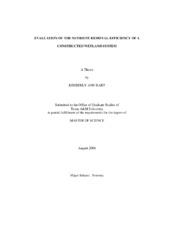| dc.description.abstract | In north central Texas, USA, free-water surface wetlands have been constructed
to treat pre-treated wastewater effluent from the Trinity River. Water quality and
vegetation data from the first two years of operation (June 2003 to May 2005) were used
to determine cell-to-cell and system-wide removal efficiency of total suspended solids
(TSS), total phosphorus (TP) and total nitrogen (TN). The wetland system consisted of
one non-vegetated sedimentation basin and a series of four connected, vegetated wetland
cells. Temporal analyses displayed varying monthly, seasonal and yearly trends of the
wetlands’ concentration of the three parameters. Spatial analysis results confirmed that
TSS, TP and TN concentrations were greater at the beginning of the system as compared
to the end of the wetland system. Percent reduction analyses showed that the second
wetland cell (WC2) was the most efficient in TSS, TP and TN removal, while the last
wetland cell (WC4) had the lowest reduction of the three parameters. TSS removal was
significant (α = 0.05) moving consecutively among the sites in the wetland system, with
exception to the last wetland cell. TP removal was only significant (α = 0.05) moving
from the third wetland cell (WC3) to WC4, while TN removal was significant (α = 0.05)
moving from the sedimentation basin to the first wetland cell (WC1) and then again
moving from WC3 to WC4. Overall removal efficiency of the wetland system (from the
Trinity River to WC4) was quite high, with reductions over 97% for TSS, 47% for TP
and 67% for TN. N:P ratios decreased moving consecutively throughout the field-scale
wetlands. Vegetation analyses found WCs 1 and 3 to contain the greatest vegetation
species richness, while WC2 had the lowest richness. The vegetative composition of the
four cells was mostly the same. A comparison was conducted between the nutrient reduction efficiency and vegetation data of this wetland system with data from a pilotscale
wetland system that was operated from 1992 to 2000. The findings of this study
suggest that during the first two years of operation, the wetland system’s performance is
comparable to the pilot-scale wetlands which were operated for eight years. | en |


